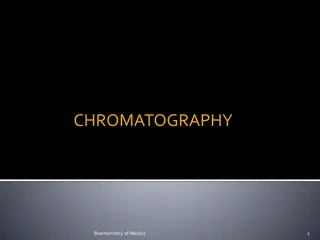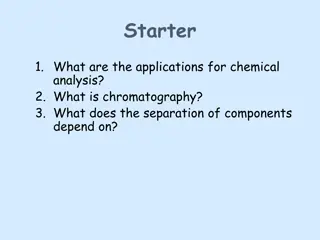Understanding High Performance Liquid Chromatography (HPLC)
High Performance Liquid Chromatography (HPLC) is a powerful analytical technique used for separating compounds in a liquid mixture based on their interactions with the stationary phase and mobile phase. It involves different types of separations, columns, mobile phases, and detection methods. Isocratic and gradient elution are two main methods in HPLC, each offering unique advantages and applications. The mobile phase delivery system plays a crucial role in introducing solvents into the column, with pumps being essential components for generating required pressures and flow rates.
Download Presentation

Please find below an Image/Link to download the presentation.
The content on the website is provided AS IS for your information and personal use only. It may not be sold, licensed, or shared on other websites without obtaining consent from the author. Download presentation by click this link. If you encounter any issues during the download, it is possible that the publisher has removed the file from their server.
E N D
Presentation Transcript
HIGH PERFORMANCE LIQUID CHROMATOGRAPHY (HPLC) What is HPLC? What is HPLC? Types of Separations Types of Separations Columns and Stationary Phases Columns and Stationary Phases Mobile Phases and Their Role in Separations Mobile Phases and Their Role in Separations Injection in HPLC Injection in HPLC Detection in HPLC Detection in HPLC Variations on Traditional HPLC Variations on Traditional HPLC Ion Chromatography Ion Chromatography Size Exclusion Chromatography Size Exclusion Chromatography
ISOCRATIC VERSUS GRADIENT ELUTION Isocratic elution has a constant mobile phase composition Isocratic elution has a constant mobile phase composition Can often use one pump! Can often use one pump! Mix solvents together ahead of time! Mix solvents together ahead of time! Simpler, no mixing chamber required Simpler, no mixing chamber required Limited flexibility, not used much in research Limited flexibility, not used much in research mostly process chemistry or routine analysis. mostly process chemistry or routine analysis. Gradient elution Gradient elutionhas a varying mobile phase composition has a varying mobile phase composition Uses multiple pumps whose output is mixed together Uses multiple pumps whose output is mixed together often 2 often 2- -4 pumps (binary to quarternary systems) 4 pumps (binary to quarternary systems) Changing mobile phase components changes the polarity index Changing mobile phase components changes the polarity index can be used to subsequently elute compounds that were previously can be used to subsequently elute compounds that were previously (intentionally) stuck on the column (intentionally) stuck on the column Some additional wear on the stationary phase Some additional wear on the stationary phase Column has to re Column has to re- -equilibrate to original conditions after each run (takes equilibrate to original conditions after each run (takes additional time). additional time).
MOBILE PHASE DELIVERY SYSTEM With varied flow rates & pressures solvent is introduced in column If system is not pulse free, pulse damping system, degasser is used to remove air/ gasses from solvent (mobile phase) Capable of delivering solvent gradient Pump operates at 100 atm 1500 psi to 400 atm to 6000 psi 0.5-2 ml/min to few l/min (micro bore)
Pumps There are a number of different types of pumps that can provide the necessary pressures and flow-rates required by the modern liquid chromatograph. In the early years of the LC renaissance, there were two types of pump in common use; they were the Pneumatic pump, where the necessary high pressures were achieved by pneumatic amplification (under pressure) syringe pump, which was simply a large, strongly constructed syringe with a plunger that was driven by a motor. Today the majority of modern chromatographs are fitted with reciprocating pumps fitted with either pistons or diaphragms.
The Pneumatic Pump The pneumatic pump has a much larger flow capacity than the piston type pumps but, nowadays, is largely used for column packing and not for general analysis. The pneumatic pump can provide extremely high pressures and is relatively inexpensive, but the high pressure models are a little cumbersome and, at high flow rates, can consume considerable quantities of compressed air. Air enters port (1) and applies a pressure to the upper piston that is directly transmitted to the lower piston. If connected to a liquid chromatograph, or column packing manifold, liquid will flow out of the left hand side non- return valve as shown in the diagram which continues until the maximum movement of the piston is reached. At the extreme of movement a micro switch is activated and the air pressure transferred from port (1) to port (2). The piston now moves in the opposite direction and draws mobile phase through the right hand non-return valve refilling the cylinder with solvent. Again on reaching the limit of the piston movement a second micro switches the air supply from port (2) back to port (1) and the process repeated. The refilling process is extremely fast and, if an appropriate pulse dampener is used, the outlet pressure remains reasonably constant during the refill cycle.
Non-Return Valves For efficient function, it is important that while the piston compresses the solvent to express it from the exit port, the flow is completely stopped at the inlet port. Conversely, when the pump draws fresh solvent into the cylinder during refill, the non-return valves must allow solvent to flow through the inlet valve but, flow-back from the exit valve must be completely stopped. This is achieved by the use of efficient non-return valves. The critical part of the valve consists of a synthetic sapphire ball resting on a seat. The seat may be of stainless steel, captured PTFE or, more commonly, also of sapphire. When the flow is directed against the ball the ball moves forward allowing the liquid to flow pass it. When the direction of pressure changes resulting in potential flow-back through the valve, the ball is driven back onto its seat and stops the flow.
The Single Piston Reciprocating Pump The single piston reciprocating pump was the first of its type to be used with high efficiency LC columns (columns packed with small particles) and is still very popular today. It is simple in design and relatively inexpensive. Most pistons of modern LC pumps are made of synthetic sapphire to reduce wear and extend the working life of the pump. The cylinder is usually made of stainless steel and is attached to two non-return valves in line with the inlet and outlet connections to the pump. The piston is driven by a stainless steel cam which forces the piston into the cylinder expressing the solvent through the exit non-return valve. After reaching the maximum movement, the piston follows the cam and returns as a result of the pressure exerted by the return spring. During this movement the cylinder is loaded with more solvent through the inlet non-return valve. The shape of the cam is cut to provide a linear movement of the piston during expression of the solvent but a sudden return movement on the refill stroke. In this way the pulse effect that results from the refill action is reduced. The pulses, however, are not completely eliminated and the detector noise resulting from these pulses is probably the most serious disadvantage of the single piston pump.
Twin Piston Pump The twin piston pumps with short stroke are among the most commonly used pumps for HPLC. Both pump heads are switched in series, whereby the piston in the first pump head delivers a specific volume per stroke. One pump is being filled while the other is delivering the solvent. An excentric disk presses piston 1 to the right and displaces the solvent. The double ball saphire valves ensure that the solvent stream can flow in only one direction. The second piston is used to produce a nearly complete pulsation damping. With the twin piston pump, a pressure of 40 MPa is achieved.
RECIPROCATING PISTON PUMPS Inexpensive, wide range of flow rates Small motor driven piston, moves rapidly back n forth in hydraulic chamber. Capacity 35-400 l. Check valves on background stroke piston sucks solvent from MP reservoir. Outlet to separating column is closed. On forward stroke, pump pushes solvent to column. Inlet from reservoir is closed. Hydraulic fluid allows pumping action to solvent via diaphragm. (minimizes contamination & corrosion of pump parts)
RECIPROCATING PUMP Stroke vol during each cycle/stroke frequently varied for flow rates. Dual head/triple head pumps identical piston chamber, but solvent delivery is smoothed bcos one piston sucks & other delivers the solvent. Solvent delivery is maintained continuous. No restriction on solvent reservoir size/operating time.
SYRINGE TYPE PUMPS Work on positive solvent displacement by piston mechanically driven at const rate. Piston is actuated by screw feed drive in geared box run by motor. Rate of flow can be changed by changing voltage of motor. Finite capacity solvent chamber 250-500ml Good for small bore columns. Pulseless flow possible with pressure capacity 200- 475 atm. Constant pressure pump
The Syringe Pump The syringe pump is a large, electrically operated simulation of a hypodermic syringe. Although used in the early days of LC renaissance, it is rarely used today as, due to its design, it can provide only a limited pressure and the volume of mobile phase available for use is restricted to the pump volume. Unless the separation is stopped while the pump is refilled and the development subsequently continued, the pump can only elute solutes that have retention volumes equal or less than the pump capacity.
PULSE DAMPERS Many detectors r sensitive to variation in flow.- R.I., Electrochemical, conductivity, fluorescent, U.V. absorbance detectors. Exhibit detector noise with flow modulation. Simple damping method: flexible bellows/compressible gas/fluid in capped up right portion of tee tube & takes some of pulsation energy. When pump refills this energy is released to smooth the pressure pulsation. Have large fluid volume. Excess pressure of 100psi r req for effective operation. Electronic pulse dampers provide small rapid forward stroke of piston & rapid refill stroke. Dampens the pulse flow. Solvent is brought upto system pressure before delivery.
SAMPLE INTRODUCTION Usually 5 to 1000 L volumes, all directly onto the column not much worry about capacity since the columns have a large volume (packed). Injector is the last component before the column(s) A source of poor precision in HPLC errors of 2-3 % are due to injection other errors are added to this due to capillary action and the small dimensions/cavities inside the injector 6-PORT Rotary Valve is the standard manual injector Automatic injectors are available Two positions, load and inject in the typical injector Injection loop internal volume determines injection volume.
HPLC HPLC - - INJECTOR INJECTOR Six-port Rheodyne valve in which the sample fills an external loop A clockwise rotation of the valve rotor places the sample-filled loop into the mobile-phase stream, with subsequent injection of the sample onto the top of the column
LOAD (the sample loop) Inject (move the sample loop into the mobile phase flow) http://www.restek.com/Technical- Resources/Injector-Animations
Micro sampling injector valves: sample dissolved in MP to avoid solvent peak. Calibrated sample loop is filled by flushing it thoroughly with sample solution by means of ordinary syringe. Rotation of the valve rotor places filled loop into MP stream with subsequent injection of sample onto the top of the column. Sample loops of different cap- 10- 20 l.























